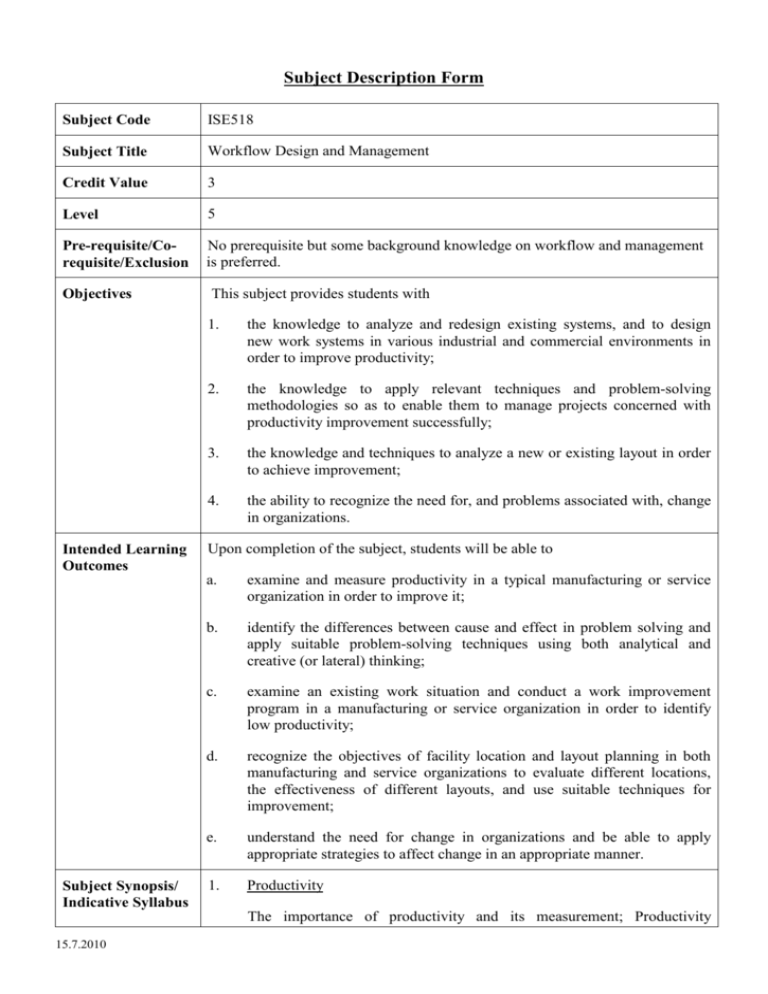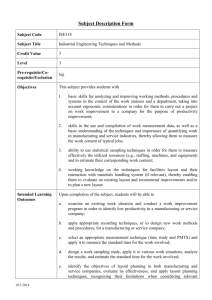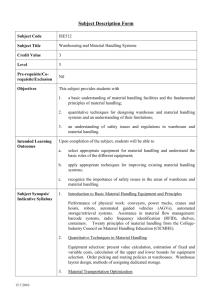
Subject Description Form
Subject Code
ISE518
Subject Title
Workflow Design and Management
Credit Value
3
Level
5
Pre-requisite/Corequisite/Exclusion
No prerequisite but some background knowledge on workflow and management
is preferred.
Objectives
Intended Learning
Outcomes
Subject Synopsis/
Indicative Syllabus
This subject provides students with
1.
the knowledge to analyze and redesign existing systems, and to design
new work systems in various industrial and commercial environments in
order to improve productivity;
2.
the knowledge to apply relevant techniques and problem-solving
methodologies so as to enable them to manage projects concerned with
productivity improvement successfully;
3.
the knowledge and techniques to analyze a new or existing layout in order
to achieve improvement;
4.
the ability to recognize the need for, and problems associated with, change
in organizations.
Upon completion of the subject, students will be able to
a.
examine and measure productivity in a typical manufacturing or service
organization in order to improve it;
b.
identify the differences between cause and effect in problem solving and
apply suitable problem-solving techniques using both analytical and
creative (or lateral) thinking;
c.
examine an existing work situation and conduct a work improvement
program in a manufacturing or service organization in order to identify
low productivity;
d.
recognize the objectives of facility location and layout planning in both
manufacturing and service organizations to evaluate different locations,
the effectiveness of different layouts, and use suitable techniques for
improvement;
e.
understand the need for change in organizations and be able to apply
appropriate strategies to affect change in an appropriate manner.
1.
Productivity
The importance of productivity and its measurement; Productivity
15.7.2010
measures in organizations; Total and partial productivity measures, their
advantages and limitations; Causes of low productivity in organizations;
Types of productivity improvement programs and how to select them.
2.
Problem Solving
General problem-solving skills; Recognizing and defining problems; Use
and applications of analytical and creative thinking; Barriers to creativity;
Methods of stimulating creative thinking, such as attribute listing, analogy,
brainstorming, etc.
3.
Work Improvement
Analysis and improvement of work methods, systems, and procedures;
Selecting areas appropriate for work improvement; Choosing areas for
improvement, recording the facts, examining, and developing
improvements; Issues of implementation, and continuous improvement;
Application to the analysis and improvement of work systems; An
appreciation of Business Process Re-engineering (BPR) and continuous
improvement, as approaches to improving work systems in organizations.
4.
Location and Facility Planning
Factors affecting the choice of location and the evaluation of alternatives;
Types of layouts, including an appreciation of the systematic layout
planning approach; Use of computers in layout planning; Types of flow
lines, and line balancing issues.
5.
Management of Change
Introduction to managing changes in organizations; Problems associated
with change and the effects that change has on the management and
personnel concerned; Organizing for change and overcoming resistance to
change.
Teaching/Learning
Methodology
Emphasis is placed on a student-centered learning approach through a variety of
case studies taken from realistic industrial and commercial situations. These case
studies are often used to deliver the subject material in a scenario of problembased learning that will integrate topics contained in the syllabus so as to make
the subject material more interesting and meaningful to students.
Typical Case Studies
15.7.2010
Measuring productivity in an engineering company
Selecting areas for methods improvement in a small batch manufacturing
company
Designing a flow-line to assemble a typical consumer product
Developing a home delivery service for a supermarket chain
Locating a centralized processing plant for a fast-food operation
Creating a layout of a manufacturing department that integrates both
production equipment and office accommodation
Managing change in a commercial enterprise
Teaching/Learning
Methodologies
Lecture
Tutorial
Project/case studies
Assessment
Methods in
Alignment with
Intended Learning
Outcomes
Intended Subject Learning Outcomes to be assessed
a
b
c
d
e
Specific assessment
methods/tasks
%
Weighting
Intended subject learning
outcomes to be assessed
a
b
c
d
e
Continuous assessment
45%
Examination (open book)
55%
Total
100 %
Continuous assessment is comprised of case studies with individual and group
components. Note: Assessment of Intended Learning Outcomes (ILOs) may vary
from year to year in terms of whether they are by continuous assessment or by
examination. However, all ILOs are covered each year. Moreover, all assessment
components require students to apply what they have learned to realistic work
applications that often integrate the various topics covered. The examination
(open-book format) is also applications oriented.
Student Study
Effort Expected
Class contact:
Lecture
3 hours/week for 7 weeks
21 Hrs.
Tutorial/case study
3 hours/week for 4 weeks
12 Hrs.
Laboratory
3 hours/week for 2 weeks
6 Hrs.
Other student study effort:
Studying and self learning
40 Hrs.
Case studies and report writing
26 Hrs.
Total student study effort
Reading List and
References
15.7.2010
105 Hrs.
1.
Adedeji B. Badiru and Olufemi A. Omitaomu 2011, Handbook on
Industrial Engineering equations, formulas and calculations, CRC Press
2.
Tristan Boutros and Tim Purdie 2014, The Process Improvement
Handbook: a Blueprint for Managing Change
Organizational Performance, McGraw-Hill Education
15.7.2010
and
Increasing
3.
Layna Fischer 2005, Workflow Handbook 2005, Future Strategies
4.
Imre Hegedus 2012, Business Process Management: Strategies to Improve
Performance, Ark Group
5.
Ricky W. Griffin 2013, Management, South-Western/Cengage Learning
6.
James A. Tompkins, John A. White, Yavuz A. Bozer and J.M.A.
Tanchoco 2010, Facilities Planning, 4th, Wiley
7.
Alberto Garcia-Diaz and J. MacGregor Smith 2008, Facilities Planning
and Design, Pearson/Prentice Hall
8.
Gavriel Salvendy 2007, Handbook of Industrial Engineering, John Wiley
& Sons, Third Edition Published Online
9.
Raybould, E, R and Minter, A, L. 1992, Problem Solving for Management,
Institute of Management Services, Latest Edition
10.
Tomkins, White, Bozer, Frazelle, Tanchoo, Trevino. 2010, Facilities
Planning, 4th edn, John Wiley & Sons Inc.
11.
International Labour Office 1992, Introduction to Work Study, 4th edn
12.
Lawrence, P (Editor) 1997, Workflow Handbook, John Wiley & Son,
Chichester
13.
Stefan Joablonski and Christoph Bussler 1996, Workflow Management Modeling Concepts, Architecture and Implementation, International
Thomson Computer Press
14.
Poyssick, G and Hannaford, S. 1996, Workflow Reengineering, Adobe
Press, Mountain View, California








